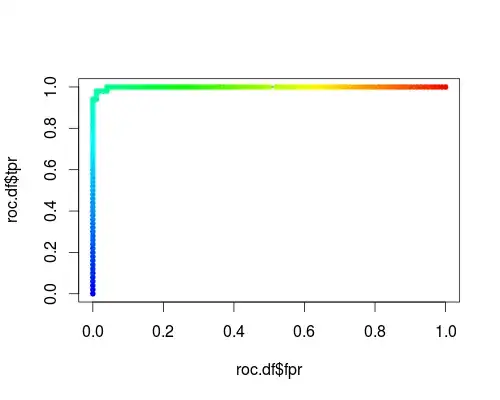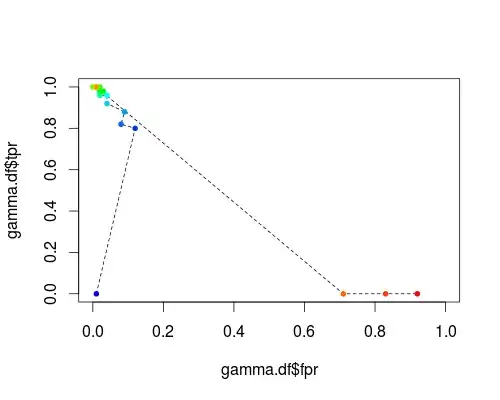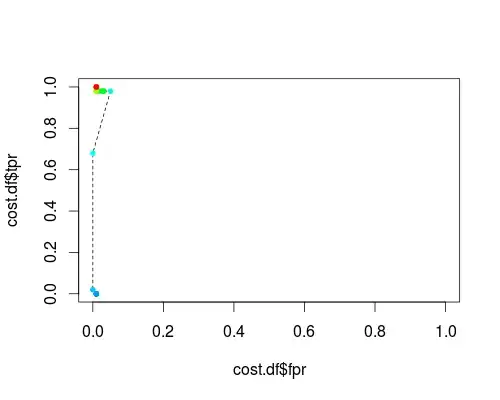Yes, there are situations where the usual receiver operating curve cannot be obtained and only one point exists.
SVMs can be set up so that they output class membership probabilities. These would be the usual value for which a threshold would be varied to produce a receiver operating curve.
Is that what you are looking for?
Steps in the ROC usually happen with small numbers of test cases rather than having anything to do with discrete variation in the covariate (particularly, you end up with the same points if you choose your discrete thresholds so that for each new point only one sample changes its assignment).
Continuously varying other (hyper)parameters of the model of course produces sets of specificity/sensitivity pairs that give other curves in the FPR;TPR coordinate system.
The interpretation of a curve of course depends on what variation did generate the curve.
Here's a usual ROC (i.e. requesting probabilities as output) for the "versicolor" class of the iris data set:
- FPR;TPR (γ = 1, C = 1, varying probability threshold):

The same type of coordinate system, but TPR and FPR as function of the tuning parameters γ and C:
FPR;TPR (varying γ, C = 1, probability threshold = 0.5):

FPR;TPR (γ = 1, varying C, probability threshold = 0.5):

These plots do have a meaning, but the meaning is decidedly different from that of the usual ROC!
Here's the R code I used:
svmperf <- function (cost = 1, gamma = 1) {
model <- svm (Species ~ ., data = iris, probability=TRUE,
cost = cost, gamma = gamma)
pred <- predict (model, iris, probability=TRUE, decision.values=TRUE)
prob.versicolor <- attr (pred, "probabilities")[, "versicolor"]
roc.pred <- prediction (prob.versicolor, iris$Species == "versicolor")
perf <- performance (roc.pred, "tpr", "fpr")
data.frame (fpr = perf@x.values [[1]], tpr = perf@y.values [[1]],
threshold = perf@alpha.values [[1]],
cost = cost, gamma = gamma)
}
df <- data.frame ()
for (cost in -10:10)
df <- rbind (df, svmperf (cost = 2^cost))
head (df)
plot (df$fpr, df$tpr)
cost.df <- split (df, df$cost)
cost.df <- sapply (cost.df, function (x) {
i <- approx (x$threshold, seq (nrow (x)), 0.5, method="constant")$y
x [i,]
})
cost.df <- as.data.frame (t (cost.df))
plot (cost.df$fpr, cost.df$tpr, type = "l", xlim = 0:1, ylim = 0:1)
points (cost.df$fpr, cost.df$tpr, pch = 20,
col = rev(rainbow(nrow (cost.df),start=0, end=4/6)))
df <- data.frame ()
for (gamma in -10:10)
df <- rbind (df, svmperf (gamma = 2^gamma))
head (df)
plot (df$fpr, df$tpr)
gamma.df <- split (df, df$gamma)
gamma.df <- sapply (gamma.df, function (x) {
i <- approx (x$threshold, seq (nrow (x)), 0.5, method="constant")$y
x [i,]
})
gamma.df <- as.data.frame (t (gamma.df))
plot (gamma.df$fpr, gamma.df$tpr, type = "l", xlim = 0:1, ylim = 0:1, lty = 2)
points (gamma.df$fpr, gamma.df$tpr, pch = 20,
col = rev(rainbow(nrow (gamma.df),start=0, end=4/6)))
roc.df <- subset (df, cost == 1 & gamma == 1)
plot (roc.df$fpr, roc.df$tpr, type = "l", xlim = 0:1, ylim = 0:1)
points (roc.df$fpr, roc.df$tpr, pch = 20,
col = rev(rainbow(nrow (roc.df),start=0, end=4/6)))


